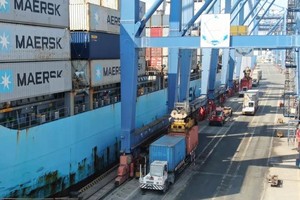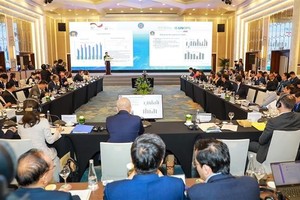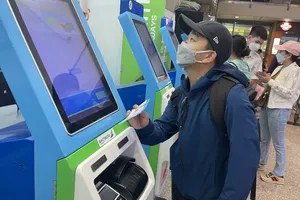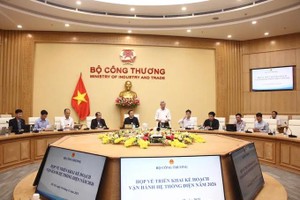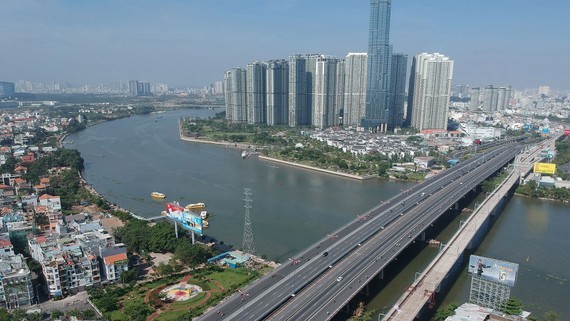 The Saigon 2 Bridge (left) is built in the form of PPP. (Photo: SGGP)
The Saigon 2 Bridge (left) is built in the form of PPP. (Photo: SGGP)
However, ever since the PPP Law took effect, this model has not attracted enough investors, although there is a lot of room for mobilizing social resources to invest in public projects.
Rights not defined
Under the PPP model the State and private investors jointly sign a contract to share benefits, risks, and responsibilities of construction of works or provision of public services. Both these entities are equal partners under the civil law in the project contract. However, the PPP Law does not clearly define the rights and obligations of each of these two entities.
According to the PPP Law, the competent agencies specified in Clause 1 in Article 5 are the Ministry, the provincial People's Committee, and the agency established by the Government or the Prime Minister. These are state management agencies, but when they appear as partners, the mode of operation bears the imprint of public authority, leading to inequality between competent authorities and investors. Competent agencies always think of themselves as state agencies with management rights, and investors are subject to their management rules.
Many investors complain that they are too discouraged when state agencies manage these projects. Although private investment accounts for 80 percent of a project, the state agencies are answerable to partners in all kinds of things, including public investment management mechanisms.
Regulations in PPP investment puts the relationship between the State and investors with equal interests of the parties. However, while state agencies require investors to fulfill many commitments, if they fail to do so, they are harassed. On the other hand, state agencies do not comply with commitments such as slow funding, self-cutting at toll stations according to the financial plan, not increasing tolls as committed, opening parallel roads to reduce traffic, or ordering to close the station or imposing non-stop toll collection conditions. All these actions affect the project's financial plan and cause damage to investors, but there is still no punishment or accountability from their side. This has led to investors being discouraged and not excited about participating in BOT projects.
Inadequacies in projects
If the capital from the state budget is not sufficient for investment in infrastructure development, especially investment in highway construction, the Government offers several policies and a favorable environment to encourage the private sector to participate in transport infrastructure investment projects under the PPP model. According to the provisions of Article 69 of the Law on PPP, the proportion of capital from the state budget participating in a PPP project must not exceed 50 percent of the total investment of the project. This part of capital includes most of the cost of site clearance. Investors take on the remaining 50 percent, but from this capital contribution a number of inadequacies arise in some projects.
Firstly, the State capital contribution rate is limited to no more than 50 percent, mainly for compensation for site clearance for project implementation, including land for road construction, rest station, and a gas station, and a part of investment costs for road construction. Such a strict regulation for state capital has made it impossible to carry out many expressway projects passing through remote areas with difficult geological and bad traffic conditions. For projects that are important for national security, or cover borders, seas, islands, and ethnic minority areas, the State should provide certain incentives. The capital from the state budget then can attract more capital. This prime capital can be through public investment to increase support for projects in remote and low-traffic areas. Therefore, the expansion of the state budget to maybe more than 50 percent, depending on the nature and characteristics of each project, is a solution that needs to be done immediately to attract investors.
Secondly, there is the problem of capital mobilization of investors. For a long time, the source of capital that investors have to mobilize for BOT projects depends on the credit channel in banks, but banks are not interested in lending. In developed countries, investment capital for infrastructure projects comes from many sources, including capital from the state budget, capital from issuing project bonds, equity of enterprises and loans from finance institutions or investment fund for highway development. In this, the highway development investment fund plays a very important role. This fund has not yet been established in Vietnam, and the project bond issuance plan is regulated in the PPP Law but there is no implementation guidance. Therefore, when the bank does not commit to credit, investors will automatically run out of opportunities.
Thirdly, there is need to solve the problem between loan interest payment and revenue of traffic BOT projects. Traffic PPP projects usually have large investment capital and long payback period. The capital recovered under the financial plan is mainly based on revenue from traffic fees. In the first years, the revenue was very low and unstable. After a while, sales gradually increased due to increase in vehicular traffic and increase in ticket prices according to the route. Simultaneously, interest expense on bank loans, which account for nearly 30 percent of total investment, were high in the first years and then gradually decreased over the years. The implementation of the above interest expense in accordance with the regulations of the Ministry of Finance under Decision 165/2022/QD-BTC, caused huge loss in business results in the first years of an investor's business, but a profit later on.
Fourthly, the authority of investors for ancillary work items along the route as prescribed in Article 48 of the Road Traffic Law belongs to the investor in the construction of the expressway. But in actuality, in most of the highway projects these items are assigned to the locality. Therefore, it is necessary to have a full plan of the network of these auxiliary works in parallel with the plan of the expressway network.
Rights not defined
Under the PPP model the State and private investors jointly sign a contract to share benefits, risks, and responsibilities of construction of works or provision of public services. Both these entities are equal partners under the civil law in the project contract. However, the PPP Law does not clearly define the rights and obligations of each of these two entities.
According to the PPP Law, the competent agencies specified in Clause 1 in Article 5 are the Ministry, the provincial People's Committee, and the agency established by the Government or the Prime Minister. These are state management agencies, but when they appear as partners, the mode of operation bears the imprint of public authority, leading to inequality between competent authorities and investors. Competent agencies always think of themselves as state agencies with management rights, and investors are subject to their management rules.
Many investors complain that they are too discouraged when state agencies manage these projects. Although private investment accounts for 80 percent of a project, the state agencies are answerable to partners in all kinds of things, including public investment management mechanisms.
Regulations in PPP investment puts the relationship between the State and investors with equal interests of the parties. However, while state agencies require investors to fulfill many commitments, if they fail to do so, they are harassed. On the other hand, state agencies do not comply with commitments such as slow funding, self-cutting at toll stations according to the financial plan, not increasing tolls as committed, opening parallel roads to reduce traffic, or ordering to close the station or imposing non-stop toll collection conditions. All these actions affect the project's financial plan and cause damage to investors, but there is still no punishment or accountability from their side. This has led to investors being discouraged and not excited about participating in BOT projects.
Inadequacies in projects
If the capital from the state budget is not sufficient for investment in infrastructure development, especially investment in highway construction, the Government offers several policies and a favorable environment to encourage the private sector to participate in transport infrastructure investment projects under the PPP model. According to the provisions of Article 69 of the Law on PPP, the proportion of capital from the state budget participating in a PPP project must not exceed 50 percent of the total investment of the project. This part of capital includes most of the cost of site clearance. Investors take on the remaining 50 percent, but from this capital contribution a number of inadequacies arise in some projects.
Firstly, the State capital contribution rate is limited to no more than 50 percent, mainly for compensation for site clearance for project implementation, including land for road construction, rest station, and a gas station, and a part of investment costs for road construction. Such a strict regulation for state capital has made it impossible to carry out many expressway projects passing through remote areas with difficult geological and bad traffic conditions. For projects that are important for national security, or cover borders, seas, islands, and ethnic minority areas, the State should provide certain incentives. The capital from the state budget then can attract more capital. This prime capital can be through public investment to increase support for projects in remote and low-traffic areas. Therefore, the expansion of the state budget to maybe more than 50 percent, depending on the nature and characteristics of each project, is a solution that needs to be done immediately to attract investors.
Secondly, there is the problem of capital mobilization of investors. For a long time, the source of capital that investors have to mobilize for BOT projects depends on the credit channel in banks, but banks are not interested in lending. In developed countries, investment capital for infrastructure projects comes from many sources, including capital from the state budget, capital from issuing project bonds, equity of enterprises and loans from finance institutions or investment fund for highway development. In this, the highway development investment fund plays a very important role. This fund has not yet been established in Vietnam, and the project bond issuance plan is regulated in the PPP Law but there is no implementation guidance. Therefore, when the bank does not commit to credit, investors will automatically run out of opportunities.
Thirdly, there is need to solve the problem between loan interest payment and revenue of traffic BOT projects. Traffic PPP projects usually have large investment capital and long payback period. The capital recovered under the financial plan is mainly based on revenue from traffic fees. In the first years, the revenue was very low and unstable. After a while, sales gradually increased due to increase in vehicular traffic and increase in ticket prices according to the route. Simultaneously, interest expense on bank loans, which account for nearly 30 percent of total investment, were high in the first years and then gradually decreased over the years. The implementation of the above interest expense in accordance with the regulations of the Ministry of Finance under Decision 165/2022/QD-BTC, caused huge loss in business results in the first years of an investor's business, but a profit later on.
Fourthly, the authority of investors for ancillary work items along the route as prescribed in Article 48 of the Road Traffic Law belongs to the investor in the construction of the expressway. But in actuality, in most of the highway projects these items are assigned to the locality. Therefore, it is necessary to have a full plan of the network of these auxiliary works in parallel with the plan of the expressway network.





